Japan [Ibaraki] Beyond ordinary itinerariesvol. 5 Kasumigaura and Mt. Tsukuba area in Ibaraki prefecture
Fascination of the area is like a constellation, it comes out when the dots are connected.
2017.04.13
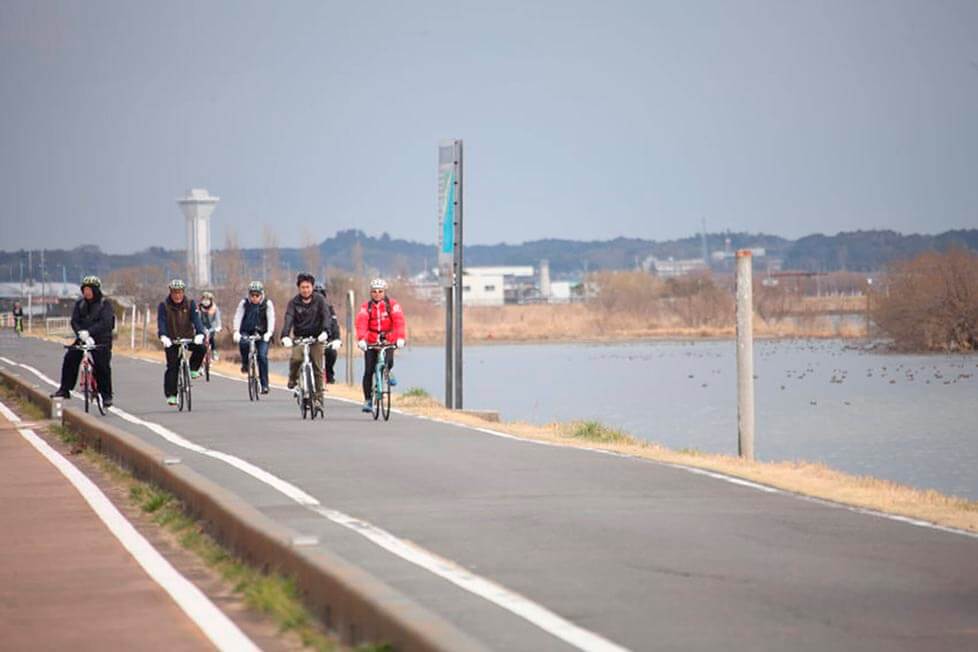
Mr. Hirotsugu Konnno, the president of Kasumigaura Mirai-dukuri Company
If Tokyo is the only destination for your trip to Japan, you may not notice that Japan is a mountainous country. According to the Japan Institute of Country-ology and Engineering, 73% of the national land area is classified as mountainous (61%) and hilly (12%), and only the 14% is flatland. Over 30% of all the Japan’s flatland is located in the Greater Tokyo Area, which is the reason you may not see any mountains in Tokyo. Here, there is a vast flatland called Kanto Plain whose total area is 17,000km2. If you landed at the Narita Airport, you may have seen just before landing the landscape, which consists of a vast plain. That’s the Kanto Plain and if you see a mountain with twin-peaks, which is quite noticeable because it lies on the flatland near the lake and the coast, the area around this mountain is the Ibaraki prefecture.
Ibaraki prefecture is located to northeast of Tokyo. Its characteristic is the vast flat land due to the Kanto plain. In fact, the habitable area in the Ibaraki prefecture, excluding the mountain area and water area, is the fourth largest of all the prefectures in Japan. The locals take advantage of this vast flat land for agriculture. Melons, sweet peppers, lettuce, Chinese lettuce, lotus roots, summer thinner leeks, chestnuts… These are the vegetables whose amount of harvest in Ibaraki is the highest in Japan. Poultry breeding is also active and it is the biggest producing prefecture of eggs. Without Ibaraki’s ingredients Tokyo’s (and even Japans’) food practices would be very different. Its reputation with people in other parts of Japan who are not aware of this fact, however, is not that favorable. It has been nominated as the worst prefecture in the survey to find “the most fascinating prefecture in Japan” for four years in a row. It reminded us of the famous word of Laozi, a great ancient Chinese philosopher, “It is wise to be modest and to not attract attention without boasting your ability and virtues.” Could it be that the Ibaraki prefecture follows this philosophy? We headed for Ibaraki with the hopes of answering this question. This time we selected, only the southern part which is an easily accessed from Tokyo.
The area around Lake Kasumigaura
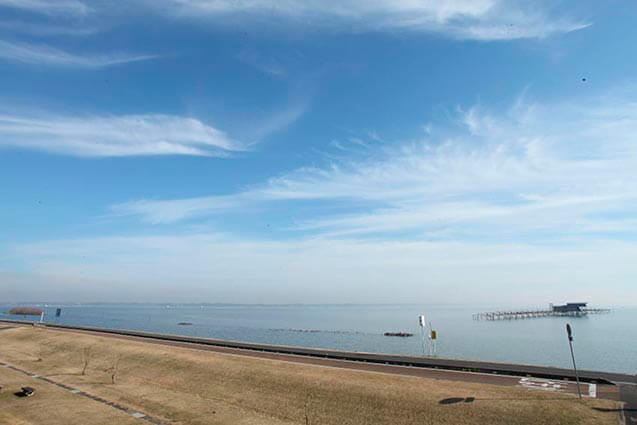
The Lake Kasumigaura, located in the southeastern part of Ibaraki prefecture, is the second largest lake in Japan (220km2) following the Lake Biwa in the Shiga prefecture. With its heart-like shape, its coastline is the longest. Currently Kasumigaura is a lake with sweet water, but up until 200 years ago it had been a cove. Over time, the amount of sea water that flowed in the cove started to decrease due to the sea-level falling. Later in 1963, a flood gate was constructed and as a result the desalination of the lake began. Now fish such as Wakasagi (small fish like delta smelt), Shirauo (trans. Salangidae), Haze (trans. Gobioidei) and Tenagaebi (trans. freshwater shrimps) are caught, and carp and catfish are cultivated as well as freshwater pearls.
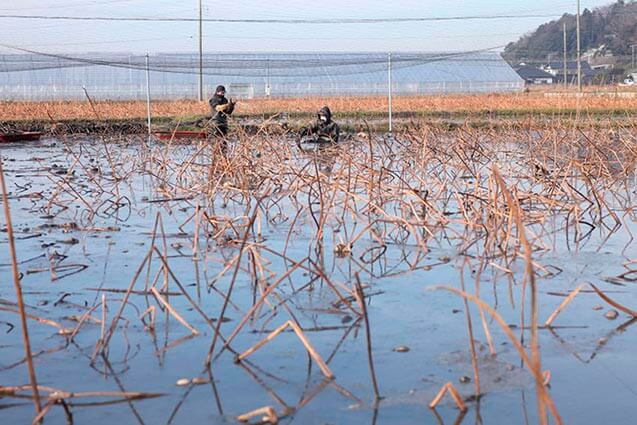
Another characteristic of the Lake Kasumigaura is that it is circulated by the fields of lotus roots cultivation. The Kasumigaura area is known as the main producing area of Ibaraki’s lotus roots. The fields of lotus roots are filled with water just like rice fields. As scenery, no one would deny its beauty in Summer when lotus flowers bloom. What very few people know, however, is that the scenery of the lotus fields from late Autumn to Winter. It is indescribably magnificent during sunset, when all the leaves are gone and only the withered branches are left above the water. As lotus fields are divided into squares, the water filling the fields reflects the color of the sky, still dark blue, and the color of the sunset on the Western horizon, which reminds us of a beautiful patchwork carpet. Also withered branches enhance its appearance, and remind us of the zen style gardens of old temples in Kyoto.
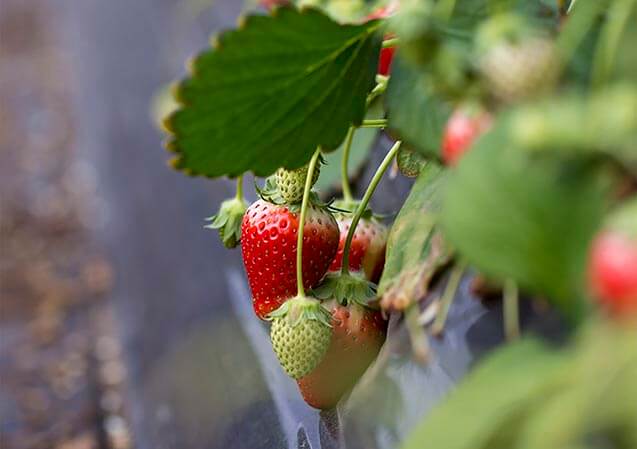
The area which used to be called Chiyoda town is famous for its fruit cultivation. There are many tourist fruit farms where the visitors can pick the fruits and eat what they picked. The history of the fruit farms in this area started soon after the modernization of Japan and when the cultivation of pear started. (cf: Japanese pear is eaten fresh, is crispier and contains more water than European varieties. Now there are farms of strawberries, grapes, Japanese pear, chestnuts, kaki (trans. persimmons) and blueberries that are cultivated and they offer fruit picking tours, depending on the season.
The Company with a Mission to Find Constellations

Mr. Hirotsugu Konnno, the president of Kasumigaura Mirai-dukuri Company
We met the president of a new company called “Kasumigaura Mirai-dukuri Company” (trans. Kasumigaura’s Future Creating Company) which was founded in April 2016 by a private company, a municipality of Kasumigaura and Tsukuba Bank, whose aim was to connect the fascinating spots, farmers and producers (who are all scattered across the area) with each other to make the whole area more fascinating.
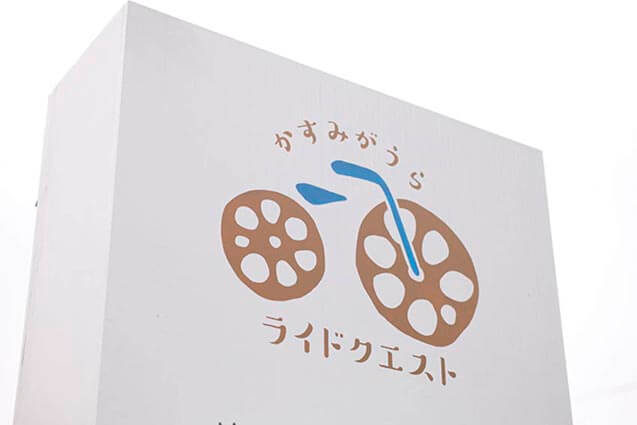
“Kasumigaura Ride Quest” promoted by Kasumigaura Mirai-dukuri Company encourages tourists to explore fruit farms and tourist spots with three courses; Short Course (25km), Long Course (50km) and a Free Plan with fee per hour.
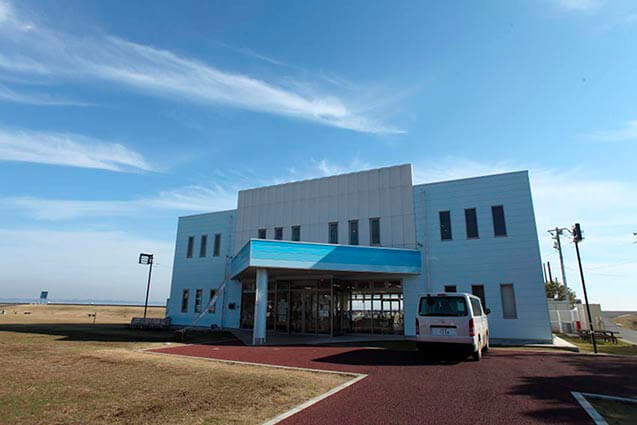
The view from the park is magnificent. It is also recommendable for those who don’t feel like going on a bicycle tour for their relaxing time. The base of Kasumigaura Ride Quest is in a modern building located in Ayumizaki Park on a beautiful lake side, where fancy bicycles are waiting for you. Biking in the Kasumigaura area is awesome. As the area is very flat, it is recommend even to those who aren’t usually physically active.
In this building there is a restaurant called Kasumi Kitchen which offers dishes cooked with local ingredients. On weekends a market, called Marché like French, of local vegetables, fruits and other products is held. Now the occasion where various local products gather is ready. From now on, more producers will participate in this project, and the managing procedure will become more efficient. When all the merits are connected, the fascination of the area will shine beautifully like a constellation. Here, we would like to introduce you some fascinating producers in the Kasumigaura area.
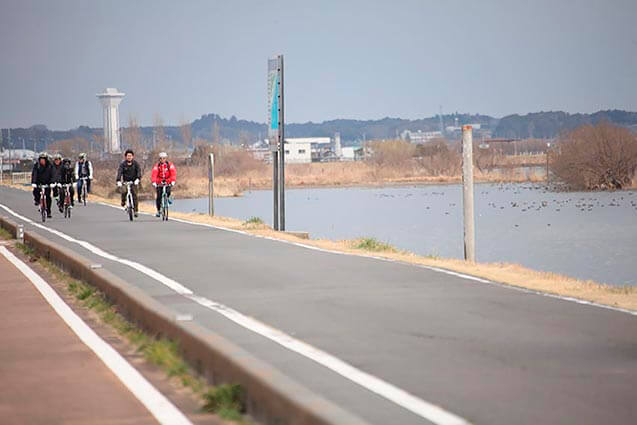
As the Kasumigaura area is very flat, bicycle touring is recommended even to those who aren’t usually physically active. It will offer more value for comfort than you expect. Grab yourself a bike and get riding to travel around the Lake Kasumigaura!
Kasumigaura Mirai-dukuri Company
4784 Saka, Kasumigaura-shi, Ibaraki prefecture
☎ 029-840-9010
Ride Quest
http://kasumigaura.miraidukuri.jp/ridequest/
Noguchi Farm – Lotus Roots -
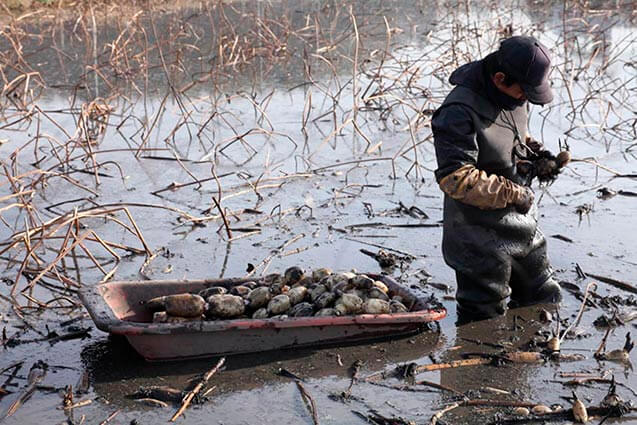
Harvesting lotus roots is very tough work. Farmers dunk themselves into the cold water in cold seasons.
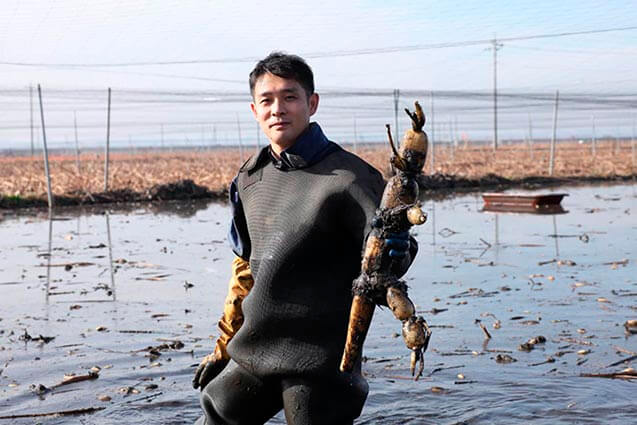
Mr. Kenichi Noguchi, Executive Director of Noguchi farm and Doctor of Sociology
Lotus roots are called renkon in Japanese. Unlike other countries, we eat lotus roots in Japan. They are called “roots” but actually they are underground stems called tubers (like potatoes). Lotus roots cut into rounds have many holes (normally from nine to ten), which are air holes. Traditionally lotus roots have been regarded as a lucky vegetable because their holes are believed to help us see the future, thus they are eaten in traditional dishes for New Years.
In the Kasumigaura area lotus roots have been cultivated for a long time, however 50 years ago the amount of cultivation increased drastically. Among all the farmers of lotus roots, Noguchi Farm is known for its quality. Noguchi Farm mainly cultivates a variety called “Ajiyoshi” (trans. good taste). Only a few Japanese people know that there are varieties of lotus roots. According to Mr. Noguchi, lotus roots are very delicate and they have their own taste and aroma depending on soil, water, environment and the cultivation method, even when they grow amongst the same variety of roots. Noguchi farm, which was founded in 1926, is taking over the cultivation method from generation to generation.
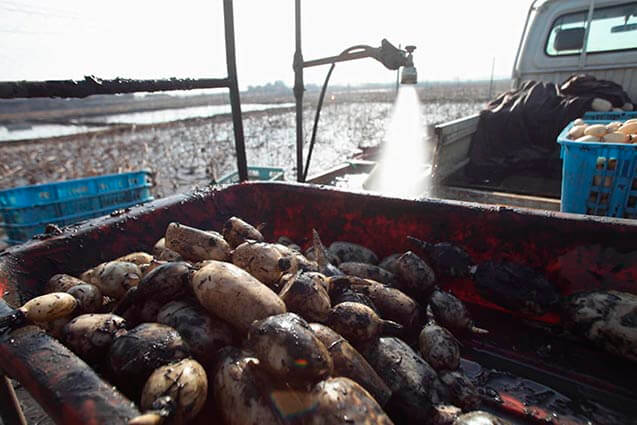
Harvesting lotus roots is hard work because they are hidden in the mud under cold water. To harvest them you dunk yourselves into the water, feel around the mud in search of the roots with your left hand and with your right hand, clear off the mud with a high-pressure cleaning machine. If harvested with a tractor the delicate roots will be damaged with a single strike. Lotus roots, even though they are a very demanding crop for farmers, are not as popular as tomatoes, which many people nominate as a favorite vegetable. However, many Japanese people answer affirmatively if they are asked, “Do you like lotus roots?” In fact, lotus roots are rarely eaten fresh and they don’t appear in salad. They are supporting vegetables, so to speak. Normally they are simmered with chicken, taro roots, carrots and burdock roots in dashi broth (trans. Japanese traditional soup stock) flavored with sugar, sake, and soy sauce. They are also good if they are deep-fried. They are tasty because they are crispy and they macerate well the soup stock. However, Ajiyoshi can be eaten fresh. It tastes like Japanese pears, which are juicy and sweet. Aiiyoshi from Noguchi farm are superb and exclusive for foodies. Due to their distinct flavor, they are popular with those who are interested in fine foods and can be purchased in beautifully displayed presentation boxes for gifting. Mr. Noguchi don’t produce outstanding lotus roots just for fun, but because he wants to make lotus roots of this area a star which attracts more people’s attention.
Hirohara Pig Farm - Lotus Roots Pork -
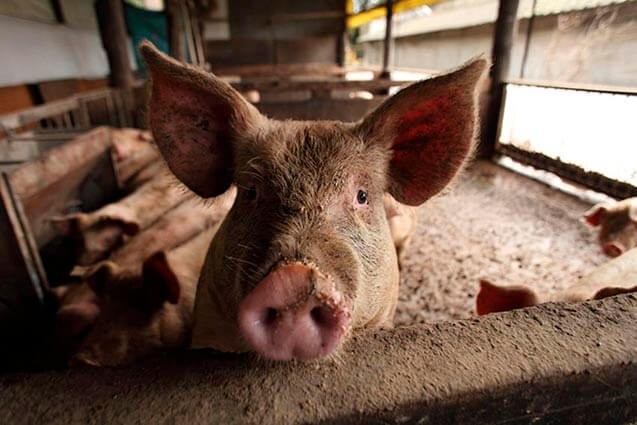
Many people may know about Spanish jamón ibérico de bellota, which is the ham from pigs that feed only on acorns just before being processed, but few know of Lotus Roots Pork, which is produced by Hirohara Pig Farm where the pigs feed lotus roots from birth.
Hirohara Pig Farm, located about 2 km from the lakeside of Kasumigaura, has 70 years of history. The concept of Lotus Roots Pork originated from an idea Mr. Hirohara’s had while supplying swine manure compost to neighboring lotus roots farms. He wanted to realize the Regional Recycling Agriculture strategy, and so decided to feed his pigs lotus roots that would otherwise be unsuitable for sale. Lotus Roots are high in Vitamin C, Vitamin B12, and dietary fiber but low in calories. So if pigs eat only lotus roots, they will be too slim and their meat will be too tough, according to Mr. Hirohara. He had continued to experiment with the amount of the lotus roots included in his feed until he found the best composition.
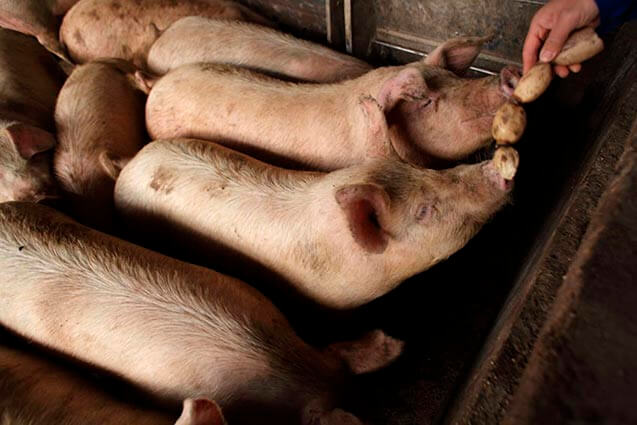
Pigs sometimes eat whole lotus roots. Chewing hard food properly has benefits not only for human beings but also for pigs.
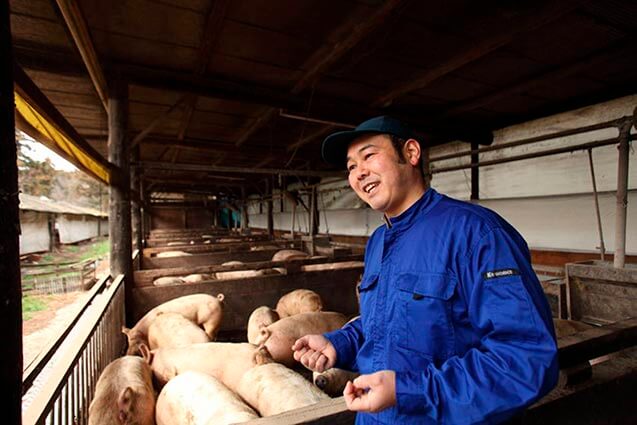
Mr. Ken Hirohara, the president of Hirohara Pig Farm
Mr. Hirohara made also silage (fermented feed). Crushed and dried lotus roots are put in vacuum storage for about a month, so the lactic acid bacterium in lotus roots can ferment, which enables the roots to be preserved for a year. Before this process was developed it had been difficult to maintain enough feed during Summer as lotus roots are harvested mainly in Autumn and Winter.
Many people may associate pig farms with a nasty smell, but this is not the case with Hirohara Pig Farm. The pens are kept clean and pigs grow healthily with love from Mr. Hirohara. This is just one of the ways it is clear that Lotus Roots Pork is of high quality.
Only the meat whose quality passes Mr. Hirohara’s standard is named Lotus Roots Pork. Its characteristics are: it doesn’t have distinct odor of pork; its fat tastes sweet; the fat melts quickly in your mouth; and it has a clean finish. According to researchers, the odor of the pork can be decreased by plant lactobacillus, which lotus roots have as a component. The quality of Lotus Roots Pork was the result of the bond between lotus roots farms and pig farms, the good relationship between lactic acid bacterium and pork, and Mr. Hirohara’s love and enthusiasm toward pigs. Mr. Hirohara wants the people who don’t like pork to try his Lotus Roots Pork (unless you are a vegetarian!). If you like pork, nothing will stop you from visiting Ibaraki for the trial.
Yamano Suisan - Catfish -

Intriguingly, Namazu (trans. catfish) was believed to be fish that caused earthquakes in Japan, especially during the Edo period (1603-1868). Many pieces of ukiyoe were printed and sold as protection from earthquakes after the great earthquake in 1855. Of course, no one believes in this folk belief currently, but still catfish is less popular compared to unagi (trans. eels) which is eaten all over Japan (even though it is endangered and on the Red List). As unagi became popular in the Edo period, that folk belief may have acted upon this significant difference. Anyway, catfish has been eaten traditionally in some regions in Japan. It is believed to be very nutritious. In some places it is served as a main dish on a festive occasion, and it is even believed to stimulate the production of breast milk. This is not a weird story that exists only in Japan. In Ancient Rome, Athenaeus, a Greek rhetorician, described the catfish in his book, Deipnosophistae (trans. dinner-table philosophers). In Germany, Hildegard of Bingen (1098-1179), who is considered to be the founder of scientific natural history, wrote about catfish, and said that it was delicious and also beneficial for the sick. In Switzerland, Conrad Gessner (1516-1565), a naturalist, described the catfish as something fit for Royal dining. Recently in Japan, since 2015, the value of catfish has been reconsidered and now it is seen as an alternative fish to unagi.
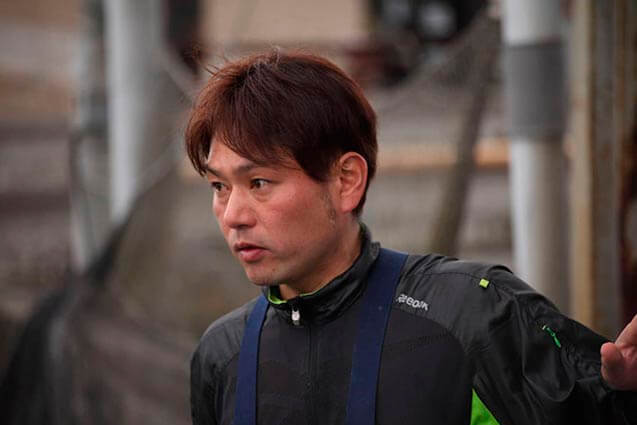
Mr. Hideaki Yamano, Director of Yamano Suisan
Still, many people (including Japanese) have a preconception that freshwater fish has a particular smell and as a result hesitate to try catfish. It was Mr. Yamano of Yamano Suisan (trans. aquatic products), who first dispelled of this concern. He did this through successfully producing catfish without odor.
Yamano Suisan is a fish farming and processing company near the Lake Kasumigaura, and cultivates freshwater fish, such as carps. He researched the odor that catfish has, analyzing the components of the odor and the factors that causes it. As a result of this research, he was able to develop fish food that clears away all that contributed to the odor. He also changed the cultivation method by placing the catfish in clean groundwater and allowed them to stay there for the last thirty days before the shipment. Exposure to the water during this time frame lets out the mud that causes the odor. In addition, to make his catfish more delicious, he covers the filleted catfish with in a sheet of kelp, full of glutamic acid which is a key component of umami (trans. savory), and soaks it in sake for an hour. This fillet can be eaten raw as sashimi. It tastes like flounder (trans. flatfish) and is faintly sweet. If you have any kinds of reservations towards trying catfish, the catfish developed by Mr. Yamano will make you more tolerant.
Shimaki-Noen - Chestnuts -

In the area between chestnuts trees rapeseeds are grown naturally. The scenery of Shimaki Farm becomes more beautiful with their yellow blooms in spring.
When thinking about chestnuts, many people are reminded of Marrons glacé, chestnuts candied in syrup and glazed. It is debated as to whether its country of origin is France or Italy, but it surely is the Savoy region, which extends over current France and current Italy. Even though Japan did not have Marrons glacé, chestnuts are considered a traditional food. Kurikinton (trans. mashed and sweetened boiled chestnuts, sometimes mixed with sweet potato paste) is one of the indispensable dishes for New Years’ celebration. Kuri-gohan (trans. chestnuts rice) is an Autumn delicacy. Chestnuts are boiled and steamed together with rice.
Chestnuts are broadly classified into four cultivars: Western (Castanea sativa), American (C. dentate), Chinese (C. mollissima) and Japanese (C. crenata). One characteristic of Japanese cultivar is that their trees don’t grow very high. Ibaraki prefecture is the biggest producing prefecture of chestnuts of Japanese cultivar. Shimaki Noen (trans. farm)’s history started at the beginning of the 20th century, when it began to develop a new variety of chestnut that can resist cold temperatures. Now they produce various varieties of chestnuts over 15 hectares land and sell chestnuts, processed food and young trees.
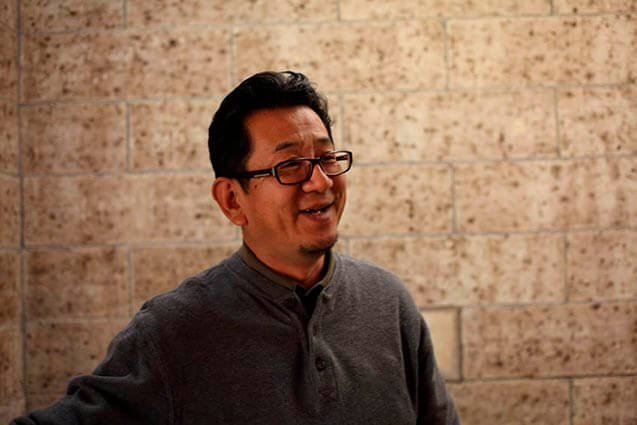
Mr. Akihiko Hyodo of Shimaki Farm
Have you ever imagined how many varieties of chestnuts exist? In Italy, for example, there are two words that indicate “chestnuts”; marrone and castagna, also in France there are marron and châtaigne. The main difference between them is the size; marrone and marron are bigger than castagna and châtaigne. To be precise, there are more varieties, according to Mr. Hyodo of Shimaki Farm. Basically the chestnuts trees grow in mountains and people pick the fallen nuts. As the fallen nuts tumble down a mountainside it is near impossible to tell the tree that they fell from. That’s why nobody really discusses the varieties of chestnuts beyond their size. On the other hand, at Shimaki Farm the varieties of chestnuts are clearly identified as their trees grow on the flatland and space is left between trees.
Mr. Shimaki made us try the raw chestnuts. That was the first taste test for us, and we actually realized that chestnuts were nuts! Raw chestnuts are crunchy like almonds but juicier when chewed. Other than raw chestnuts (for cooking), chestnut jams, Shibukawani (trans. compote of chestnuts with astringent skin) and Kurikinton are available at the shop of Shimaki Farm. Don’t miss their Marron softcream (trans. soft serve ice-cream). Its dense flavor of chestnuts will make you happy.
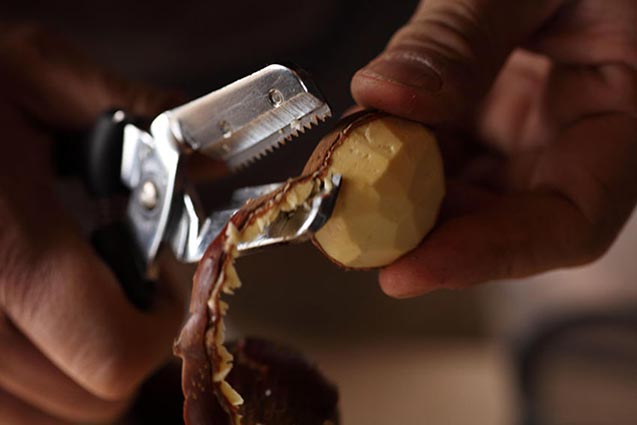
Mr. Hyodo peeled the husk and another skin underneath (called astringent) so quickly with a tool made specially for peeling chestnuts in the Tsubame-Sanjo area, Niigata.
Shimaki Farm is fascinating not only because of the chestnuts but also because of their beautifully renovated old wooden house and a stone-built warehouse where exhibitions of artworks and concerts are held. Everything, even tractors are beautifully placed, which is soothing and relaxing to look at. The starting point of Ride Quest’s short course is at Shimaki Farm. The participants will go on a tour by bicycle to a fruits farm, enjoying the scenery of the Kasumigaura area. How splendid!
Shimaki Noen
1020-24 Tsuchida, Kasumigaura-shi, Ibaraki prefecture
☎ 0299-59-2038
The Area of Mt. Tsukuba
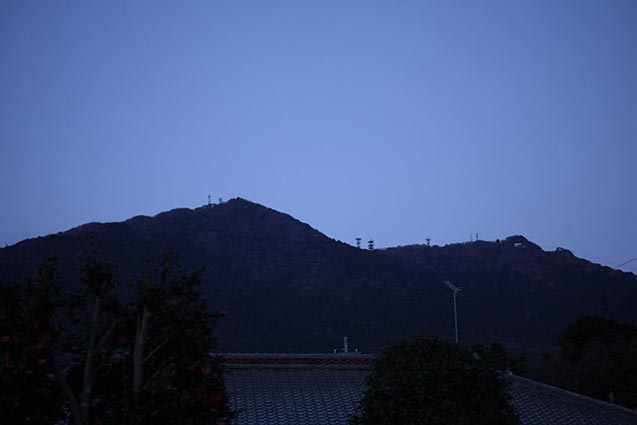
Taking advantage of its vast flatland, the Southeastern part of the Ibaraki prefecture is suitable for bicycle touring. In fact, other than Kasumigaura Ride Quest programs, a long bicycle road circling Lake Kasumigaura (approx. 94km) and a trans-city bicycle road called “Tsukuba-Kasumigaura Rin Rin Road” (cf: Rin Rin is the an onomatopoeic word for a bell.) from Kasumigaura-shi to the Tsukuba area via Tsuchiura-shi, which has a total length of 180km, is being developed.
Mt. Tsukuba has been very popular for a long time. People in Edo (Tokyo) loved it and nominated the two beautiful mountains as “Mt. Fuji of the West, Mt. Tsukuba of the East". In fact, a famous Ukiyoe artist, Utagawa Hiroshige, liked to draw Mt. Fuji from the back view when he drew the landscape overlooking the West from the town of Edo. He also drew the back view of Mt. Tsukuba, overlooking the north or northeast. Mt. Tsukuba is not that high compared to Mt. Fuji. It is 877m high, which is less than a quarter of Mt. Fuji (3,776m). The distance from Nihonbashi of Edo to Mt. Fuji is about 120 km, while Mt. Tsukuba is about 60 km. Considering their difference from Edo’s plains and their heights, these two mountains from a long distance may have appeared to be nearly the same height in the Edo period when there were no high buildings that disturbed the scenery. Beauty is also a characteristic in common of these two fabulous mountains. Mt. Tsukuba is a mountain that changes its color depending on the season. In Autumn it is in yellow and red with Autumn leaves, and in Spring it is pink with plum blossoms. Many people visit for mountain climbing, but a ropeway and a cable car are installed for those who want to go up the mountain easily and quickly.
If you want to go directly to the Mt. Tsukuba area from Tokyo, take Tsukuba Express from Akihabara station. It takes only 47 minutes! Here are two recommendable places near Mt. Tsukuba.
Inaba Shuzo - Sake Brewery-
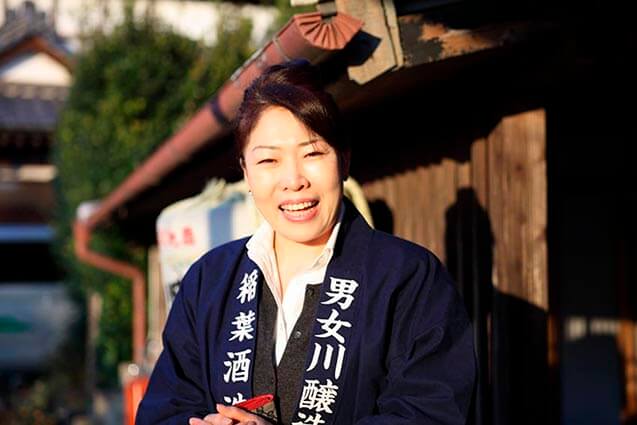
Mrs. Nobuko Inaba, the responsible sake brewer of Inaba Shuzo.
At the foot of Mt. Tsukuba, near the rest area of Tsukuba-Kasumigaura Rin Rin Road, there is a sake brewery where a woman is brewing sake, Inaba Shuzo (trans. brewery). Since its establishment it has offered its sake to Tsukubasan Jinja (trans. Shrine of Mt. Tsukuba). As mentioned earlier, Mt. Tsukuba has twin peaks. One is considered as the peak where a male god lies and is called Nantai-zan (trans. Male Mountain) and the other is considered the female peak with a goddess and is called Nyotaizan (trans. Female Mountain). The one which is slightly lower is the male one! That holy sake brewed by Inaba Brewery was named after the river that flows between the male peak and the female peak as Minano-gawa (trans. the Minano River) (cf: Male and female river if it is written in kanji but its pronunciation is Minano River.) Mrs. Inaba learned the sake brewing process in order to become the sixth toji (trans. the responsible person in charge of the elaborate sake making process). Historically toji had long been recognized as a job that only men can do. However, Mrs. Inaba’s enthusiasm in sake making broke that preconception.
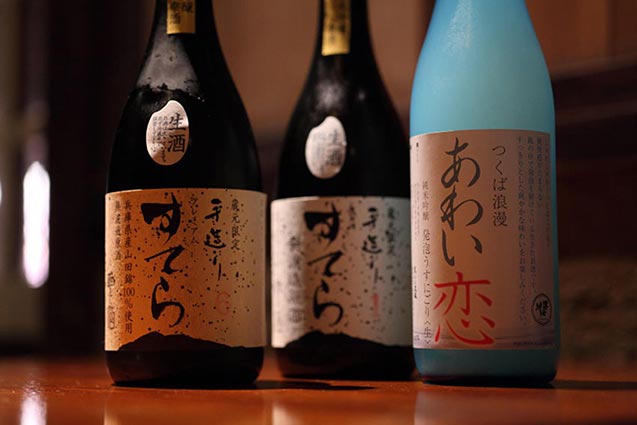
Before her decision to continue the family business when she was thirty years old, she had a career in business as a buyer in department store. In Japan, the family business is normally succeeded by the first son. However, she was born as the first daughter in the Inaba family. She has a little sister but no brothers. Moreover, their family business is sake brewing in which traditionally women were not allowed to engage in. Her father had once decided to abandon the family business until she showed her interest and enthusiasm toward him. She did not want to give up continuing the sake brewery just because she was female. She loved watching the process of sake brewing since she was a child. Knowing the toughness of sake brewing, however, her parents still disagreed to her decision.
Some professors and students of Tsukuba University who sympathized with her worked together to support this very uncommon sake brewery run by a woman. She made tanks and tools smaller so a female who has less strength can use them easily. However, the method of sake brewing that she uses is from her father, which has been passed on from generation to generation in her family. Now she brews sake with her husband who is helping her with managing the brewery. They are dedicated to brew only the highest quality sake regardless of cost and labor that it takes. All the process is manually done and the extracting procedure is done without squeezing to let sake drop naturally. They don’t charcoal filter sake and never adjust flavor afterward. Their sake is brewed by the process which they believe is the best, and the bottle labels have a tank number recorded on them, as they believe that the taste of sake is different from tank to tank where sake is left to age. In Inaba Brewery you can see the sake brewing (except for during the busy period from November to February. Reservation required). There is a café on-site that offers lunch made with local ingredients and sake. You can try various types of sake, too (Reservation required).
Inaba Shuzo
1485 Numata, Tsukuba-shi, Ibaraki prefecture
TEL: 029-866-0020
www. minanogawa.jp
Hitachino - Hitachi Beef -
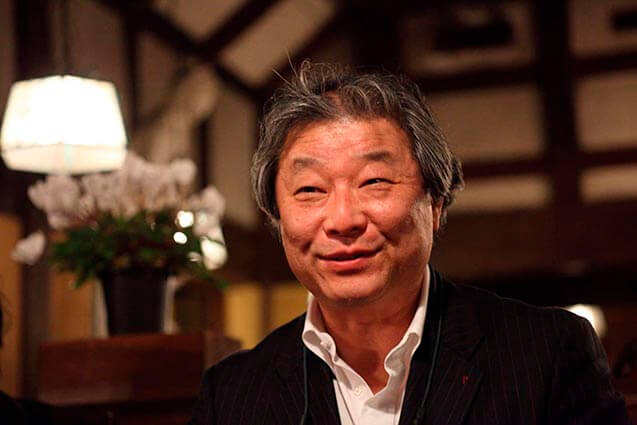
Mr. Kazuhiko Onizawa, the owner of the restaurant Hitachino.
Quaint old houses are situated near the boarding place of the ropeway heading for the top of Mt. Tsukuba on a mountain pass called Kazekaeshi toge (trans. Mountain pass). Kazekaeshi literally means “wind returns”. It is said that the origin of its name is inspired by the wind from the ocean that rebounds from the steep mountain slope that blocks its path. These houses are built in the style called Gassho-dukuri, which is not the traditional type of this region but of the Shirakawa village in Gifu prefecture, where Gassho-dukuri styled houses gathered. The characteristic of the houses is the steep roof which resembles Gassho (trans. The shape of hands folded in prayer). Three two-hundred-year-old Gassho style houses, which were scheduled to be torn down, were bought and transported here. These houses are used as a restaurant that offers exquisite Hitachi beef, which is raised in Ibaraki prefecture.
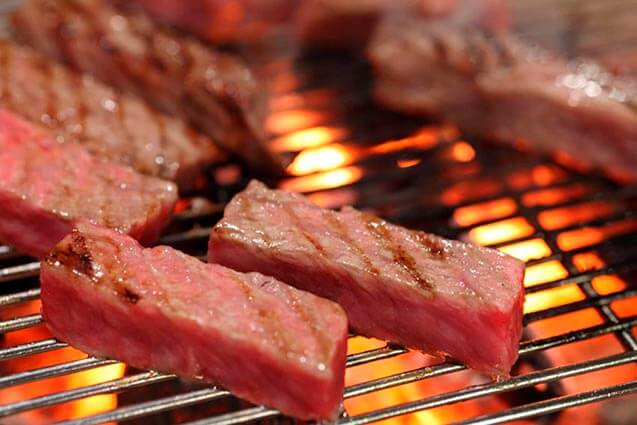
Cattle breeding of this area began during the end of the Edo period by the father of the last Shogun, who was the feudal lord of the Mito domain in the area now called Ibaraki prefecture. So Hitachi Beef is not only delicious but also has long history. The taste of Hitachi Beef is as rich as the internationally famous Kobe Beef or Matsuzaka Beef though it hasn’t achieved the same level of fame yet. It has a smooth texture, not too hard and not too soft. Fat is marbling in the red meat and it is very juicy, but not heavy. The rich after taste lasts long in your mouth but you never feel the greasiness.
You can also eat outside during the daytime and appreciate the magnificent scenery of the Tsukuba area. The beauty of the sunset is beyond description. For those who go up the Mt. Tsukuba by bicycle and who go on a hike, Hitachi Beef is a great reward for hard work! Moreover, we recommend that you spend your day in the Kasumigaura area and then go up the Mt. Tsukuba to enjoy the beautiful scenery in the evening. A dinner with Hitachi beef will conclude your extravagant visit in the southern part of Ibaraki!
Tsukuba-san Hitachino
2103-5 Usui, Tsukuba-shi, Ibaraki prefecture
☎ 029-866-1221
www.hitachino.com
About the project “Beyond ordinary itineraries”
vol.1 The Chichibu area in Saitama prefecture
A great attempt to make a new tradition in the Chichibu area
-Venture Whisky, Ichiro’s Malt-
A great attempt to make a new tradition in the Chichibu area
-Maple Base-
A great attempt to make a new tradition in the Chichibu area
-House of Miyamoto, an old farmhouse-
A great attempt to make a new tradition in the Chichibu area
-Chichibu Meisen House-
(The Chichibu area in Saitama prefecture Booklet PDF)
(The Chichibu area in Saitama prefecture Booklet PDF [for printing])
vol.2 The Hokuso area in Chiba prefecture
Tradition - inheriting the spirit and soul-
(The Hokuso area in Chiba prefecture Booklet PDF)
(The Hokuso area in Chiba prefecture Booklet PDF [for printing])
vol.3 Niigata prefecture Tsubame-Sanjo
The place for Artisans who breathe life into their craft
vol.4 Niigata prefecture Niigata city
The Power of Fermentation Can Also Connect People, Events and Products
(Niigata prefecture Niigata city&Tsubame-Sanjo Booklet PDF)
(Niigata prefecture Niigata city&Tsubame-Sanjo Booklet PDF [for printing])
vol.5 Kasumigaura and Mt.Tsukuba area in Ibaraki Prefecture
Fascination of the area is like a constellation, it comes out when the dots are connected.
(Kasumigaura and Mt.Tsukuba area in Ibaraki Prefecture Booklet PDF)
(Kasumigaura and Mt.Tsukuba area in Ibaraki Prefecture Booklet PDF [for printing])
This project is supported by the Kanto Bureau of Economy, Trade and Industry.









